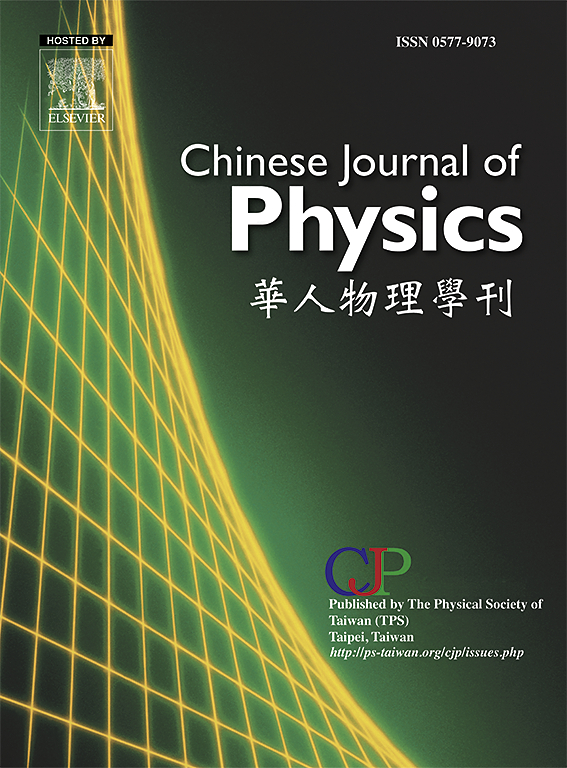在实验室实验中探索重磁化尘埃等离子体的动力学以及太阳风与月球终结者的相互作用:极化力作用的理论预测
IF 4.6
2区 物理与天体物理
Q1 PHYSICS, MULTIDISCIPLINARY
引用次数: 0
摘要
这项研究的动机是,缺乏将空间尘埃等离子体(DP)动力学与现有实验发现以及磁场在大质量 DP 中的作用联系起来的研究。为此,我们提出了强磁化(实验)和弱磁化(空间)DP 动力学的理论解释,包括极化力(PF)的影响。我们使用多流体模型来描述尘埃粒子的动力学,而电子和离子的热等离子体则用玻尔兹曼分布来描述。我们推导了频散关系,以研究压缩尘埃声波(DAWs)的行为。为了全面了解尘埃粒子的机理,我们利用还原扰动技术获得了扎哈罗夫-库兹涅佐夫方程(ZK)的周期性解,这与观测到的波剖面不谋而合。在实验应用中,我们观察到非传播不稳定性始于极化参数(R)的较小值,即 0.02。因此,对于 R 值小于 0.02 的情况,线性分析表明,增加极化参数值对区分增长率并不重要。此外,我们还注意到,R 和外加磁场都会增强波电场的强度。有趣的是,计算在高磁场作用下尘埃粒子悬浮所需的电场值与我们的理论发现一致。目前的模型也被应用于在月球终结者观测到的 DP。我们的结果表明,PF 在月球终结者中没有发挥作用。利用新罕布什尔分散关系求解器(NHDS)进行的分析证实,在太阳风与月球终结者的相互作用中,静电模式占主导地位。此外,在等离子体参数(如太阳风电子和离子的温度以及尘埃粒子和太阳风电子的密度)达到一定值时,流体弥散曲线上会出现一个与归一化波数的一定值相对应的截止点。这种静电剖面可能是在月球终结者水平方向上观测到辉光的原因。本文章由计算机程序翻译,如有差异,请以英文原文为准。

Exploring the dynamics of the heavy magnetized dusty plasma in laboratory experiments and solar wind interaction with lunar terminator: Theoretical predictions into the role of polarization force
This study is motivated by the lack of research that connects the dynamics of space dusty plasma (DP) with the existing experimental findings and the role of the magnetic field in the case of massive DP. For that purpose, we presented a theoretical interpretation of the dynamics of strongly (experimental) and weakly (space) magnetized DP, including the influence of the polarization force (PF). We used the multifluid model to describe the dynamics of dust particles while the hot plasma of electrons and ions is described by the Boltzmann distribution. We derived the dispersion relation to investigate the behavior of the compressive dust-acoustic waves (DAWs). To get a full picture of the mechanism of dust particles, we used the reductive perturbation technique to obtain the periodic solution for the Zakharov–Kuznetsov equation (ZK), which is coincidental with the observed wave profiles. In the case of the experimental application, we observed that the non-propagating instability starts at a small value of the polarization parameter (), which is 0.02. Therefore, for values of less than 0.02, the linear analysis revealed that increasing the value of the polarization parameter is not significant in distinguishing the growth rates. Moreover, we noted that both and the applied magnetic field enhance the strength of the wave electric field. Interestingly, calculating the value of the electric field required to levitate the dust particles that are subject to a high magnetic field agrees with our theoretical findings. The current model has also been applied to DP observed in the lunar terminator. Our results reveal no role for the PF in the lunar terminator. The analysis conducted using the New Hampshire Dispersion Relation Solver (NHDS) confirms the dominance of electrostatic modes in response to the solar wind interaction with the lunar terminator. Moreover, at certain values of plasma parameters such as the temperature of solar wind electrons and ions and the density of dust particles and solar wind electrons, there is a cutoff in the fluid dispersion curve corresponding to certain values of the normalized wavenumber. Such electrostatic profiles could contribute to the observed glow in the horizontal direction of the lunar terminator.
求助全文
通过发布文献求助,成功后即可免费获取论文全文。
去求助
来源期刊

Chinese Journal of Physics
物理-物理:综合
CiteScore
8.50
自引率
10.00%
发文量
361
审稿时长
44 days
期刊介绍:
The Chinese Journal of Physics publishes important advances in various branches in physics, including statistical and biophysical physics, condensed matter physics, atomic/molecular physics, optics, particle physics and nuclear physics.
The editors welcome manuscripts on:
-General Physics: Statistical and Quantum Mechanics, etc.-
Gravitation and Astrophysics-
Elementary Particles and Fields-
Nuclear Physics-
Atomic, Molecular, and Optical Physics-
Quantum Information and Quantum Computation-
Fluid Dynamics, Nonlinear Dynamics, Chaos, and Complex Networks-
Plasma and Beam Physics-
Condensed Matter: Structure, etc.-
Condensed Matter: Electronic Properties, etc.-
Polymer, Soft Matter, Biological, and Interdisciplinary Physics.
CJP publishes regular research papers, feature articles and review papers.
 求助内容:
求助内容: 应助结果提醒方式:
应助结果提醒方式:


